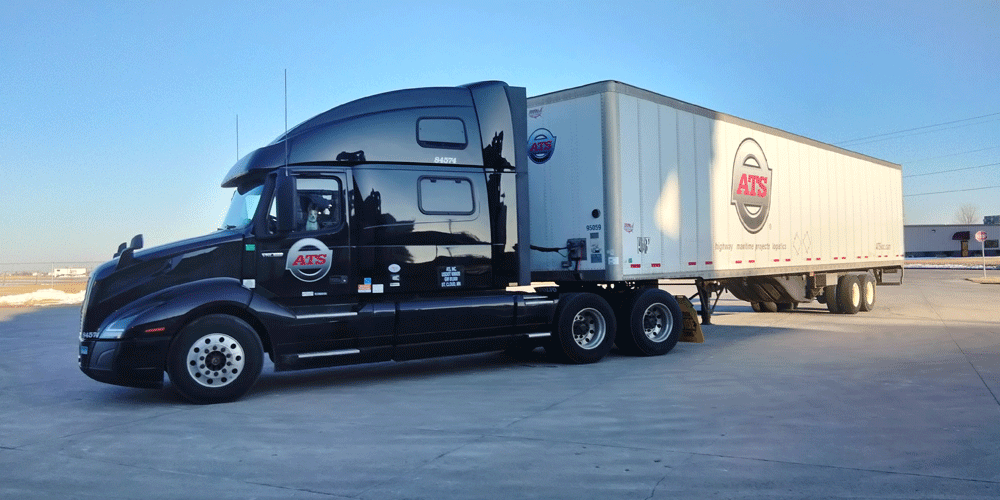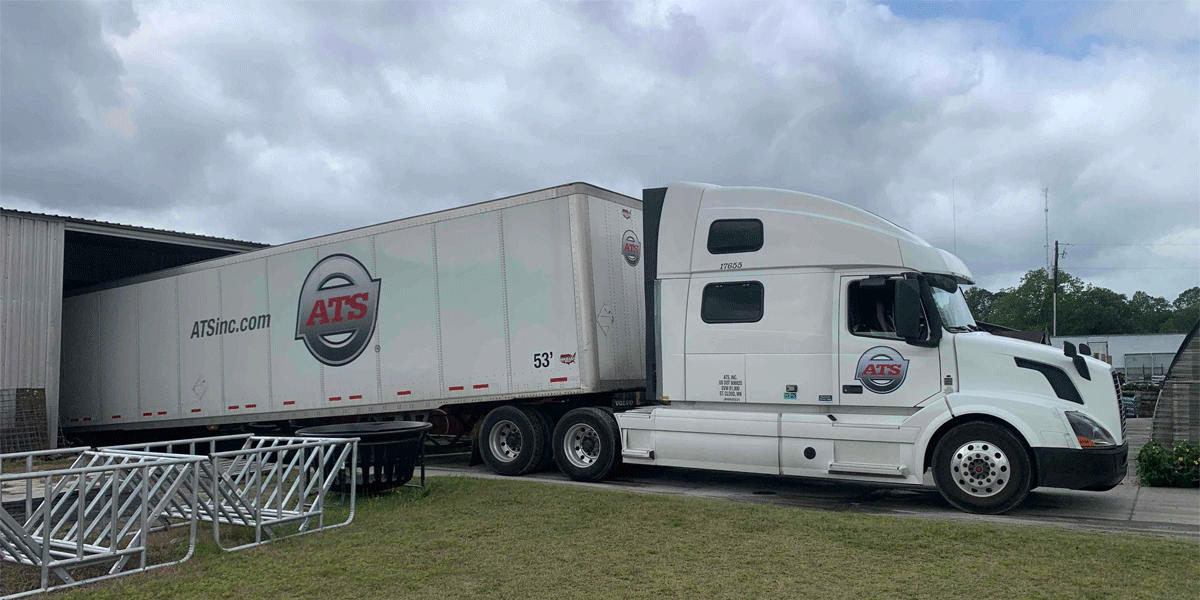Jakob Leon is an operations manager in the vans division. He loves being able to help people each day, whether they’re internal staff or valuable drivers out on the road. He enjoys working at ATS because the culture makes coming into work every day enjoyable. Prior to working at ATS, he was director of operations at Midwest Specialized. He’s also worked in the transportation industry for more than eight years in a variety of roles including over-the-road fleet manager, dedicated fleet manager and weekend operations manager. This experience helped him come to ATS with a diverse background within the van business.
Checking out your options as a truck driver?
The word “dedicated” is thrown around a lot in the trucking industry, but it can mean a few different things.
Here at Anderson Trucking Service (ATS), we’ve noticed an increased number of drivers wondering about the difference between dedicated lanes and dedicated customer freight.
It’s time to set the record straight for all drivers. There’s nothing worse than thinking you’re getting yourself into one type of trucking only to find out it’s something a little different.
I’ve spent some time working with carriers who only ran dedicated freight, so I’m well versed on its ins and outs. Now, in my role at ATS, I help with ATS Power Zones — engineered dedicated routes designed to get you home more and put more money in your pocket.
I’ll help you understand the difference between dedicated lanes and dedicated customer freight so you can decide which suits your lifestyle best.
Then you can comfortably take the next step to find the company that offers what you’re looking for.
What are Dedicated Lanes?
With dedicated lanes, drivers go from Point A to Point B and back again — day after day, week after week and month after month (you get the point). They consistently service the same customer/warehouse/shipper. Oftentimes, one driver or a handful of drivers are assigned the dedicated lane to service that one particular location.
These drivers bring freight to Point A and either go back to Point B empty or bring random freight back. Because these dedicated drivers are servicing a specific customer at one location, they need to keep moving to avoid delaying the supply chain.
Even if they don’t have freight to take back to Point B, they’ll need to drive back immediately to pick up more freight— and they’ll get paid if they’re empty. This is called a dry run.
If drivers fail to keep moving consistently like this, it can stall the whole process for that customer or warehouse. Imagine that the drivers are delivering parts to a car manufacturer. Failure to keep moving the freight can cause the manufacturer significant delays. Without the parts, they won’t be able to keep assembling the vehicles.
They might have to pause cars on the line, unable to add the next piece until drivers deliver the needed parts. As a result, they might get behind on their shipments to car dealerships. This can cause them to lose revenue.
That’s why drivers are paid for dry runs — to ensure drivers are always in position, moving freight and keeping the customer up and running.
If they didn’t work with these drivers running dedicated lanes, the customer would have to find power-only capacity (drivers with trucks only, not trailers). They’d have to pay for both dry runs and power-only capacity, which wouldn’t be cost-efficient. It simply makes more sense to have solely dedicated lanes.
What is Dedicated Customer Freight?
Dedicated customer freight is a little different than dedicated freight. It consists of one dedicated customer with a series of warehouses/shippers/plants/vendors. A dedicated fleet of drivers runs in and out of the network of lanes. Drivers don’t haul freight for any other customers, but they do haul freight to different locations.
For example, a customer might have warehouses in Ohio, Kentucky and Tennessee and they have manufacturing plants in Wisconsin. The parts from the warehouses feed into the plants. Drivers spend their time going between the warehouse and manufacturing plants.
This is how it differs from a dedicated lane. While both involve servicing one customer, a dedicated lane goes back and forth to one location and dedicated customer freight goes to a handful of locations.

The Pros of Running Dedicated Lanes and Freight
As they’re so similar, drivers enjoy running dedicated lanes and dedicated customer freight for the same reasons. This freight is very consistent and provides a more stable paycheck. You’ll know what to expect week after week — from your route to the type of freight you’re hauling.
When you run similar lanes consistently, you become accustomed to them. You get to know your routes which helps you become a safer driver. You know the twists and turns of the road, you know the areas that are busy and you know exactly where to stop. There’s no guessing how to pull into the warehouse.
It’s easier to build a consistent routine when you move dedicated freight. You’ll be passing the same areas consistently, so you can trip plan a lot easier. You might go to one truck stop on Mondays when it’s less busy but fill up on Thursdays in another location. This also helps with finding parking, which is especially nice at a time when it seems like we’re running out of parking spots for commercial truck drivers.
Home time is also fairly consistent when you’re moving dedicated freight — especially when compared to over-the-road (OTR) driving. Drivers often go home weekly.
As a driver running dedicated lanes, you’ll get to know the customers you’re servicing. It’ll be easier to build relationships because you’ll be seeing the same customers every week or every few weeks (depending on whether you’re on a dedicated lane or dedicated customer freight).
The Cons of Running Dedicated Lanes and Freight
While some drivers thrive on the consistency provided by dedicated freight and dedicated customers, others are easily bored by it. They get sick of running the same routes repeatedly and seeing the same sites. They want freight variety. They may also like the potential to earn more by hauling different types of freight week to week.
If the customer you’re moving freight for has a slow week or happens to shut down for machine maintenance or something else, it can negatively impact you. You either won’t have any freight to move or there will be very little freight and you won’t earn as much money.
Your company may make you pivot and run OTR freight for a while. If you aren’t accustomed to running this type of freight, it can be a big change that takes you out of your comfort zone.
This is subject to what the carrier has in their network for you to run. If the carrier doesn’t have additional freight, you might have to take (unpaid) home time.
Making Your Decision
Because dedicated lanes and dedicated customer freight aren’t that different from each other, it shouldn’t be too difficult of a decision.
If you prefer a little more variety, you might like running dedicated customer freight more. If you prefer to just go back and forth from one location, a dedicated lane might be best for you.
When deciding, make sure you talk to different carriers and understand who offers what. Make sure you’re speaking the same language as your recruiter when you’re talking to them about the type of freight they haul.

Run Engineered Dedicated Lanes with ATS
The choice between dedicated lanes and dedicated customer freight ultimately depends on your preferences and priorities. Both options offer a consistent and stable workload, providing you with the benefit of familiar routes and regular home time. However, you should be aware of the nuances that distinguish the two.
Dedicated lanes involve serving a single customer at one location — shuttling back and forth regularly. The emphasis is on maintaining a constant flow to prevent disruptions in the supply chain. On the other hand, dedicated customer freight expands the service to multiple locations for one customer, offering a bit more variety in the routes.
Be sure you explore your options and align your expectations with recruiters when you’re talking to different companies. This will empower you to make an informed choice that aligns with your lifestyle and goals.
Engineered dedicated lanes — offered by ATS — are different from dedicated lanes and dedicated customer freight, but they utilize a similar concept. A dedicated group of drivers serves multiple customers along similar routes.
For instance, a driver may bounce from the Minneapolis area to the Chicago area to the Kansas City area serving different customers. These engineered routes allow drivers the opportunity to go home more often and earn more.
To learn more about the dedicated freight ATS offers, you can check out our website or speak to a recruiter.

